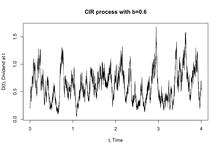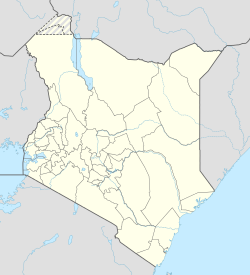콕스-잉거솔-로스 모형
Cox–Ingersoll–Ross model
수학 금융에서 콕스-잉거솔-로스(CIR) 모델은 이자율의 진화를 설명합니다. 금리 움직임을 시장 위험의 단 하나의 원천에 의해 움직이는 것으로 설명하기 때문에 "원 팩터 모델"(단기 금리 모델)의 한 유형입니다. 이 모델은 이자율 파생상품의 평가에 사용될 수 있습니다. 1985년[1] 존 C에 의해 소개되었습니다. 콕스, 조나단 E. 잉거솔과 스티븐 A. 로스는 바시섹 모델의 연장선상에 있습니다.
모델이

CIR 모델은 확률적 미분 방정식인 Feller 제곱근 프로세스를 사용하여 순간 이자율 를 설명합니다.
여기서 는 Wiener 프로세스(랜덤 시장 위험 요소 모델링)이며 a b b및σ \sigma \,}가 매개 변수입니다. 매개 a{\a}는 b{\ b에 대한 조정 속도에 해당하고σ {\displaystyle\sigma \,}는 변동성에 해당합니다. 드리프트 인자 - r ) a - r_는 Vasicek 모형에서와 정확히 같습니다. 조정 속도는 엄격하게 양의 파라미터 a에 의해 제어되며 장기 값 b를 향한 이자율의 평균 복귀를 보장합니다
표준 편차 인σrt r_t}}}은(는 {\ a 및bdisplaystyle b의 모든 양의값에 대해 마이너스 금리가 발생할 가능성을 방지합니다. 또한 조건이 발생하면 0의 금리도 배제됩니다.
충족됩니다. 보다 일반적으로 속도( 가 0에 가까우면 편차 σrt {r_t}}})도 매우 작아져서 속도에 대한 무작위 충격의 영향이 줄어듭니다. 결과적으로 속도가 0에 가까워지면 속도를 (평형을 향해) 위로 밀어 올리는 드리프트 팩터에 의해 진화가 지배됩니다.
케이스 b =σ 2 {\displaystyle 2ab=\ sigma ^{2}\,}의 경우, 펠러 제곱근 과정은 오른슈타인의 제곱으로부터 구할 수 있습니다.울렌벡 과정. 에르고딕이며 고정 분포를 가지고 있습니다. Heston 모형에서 확률적 변동성을 모형화하는 데 사용됩니다.
분배
- 미래분포
- CIR 프로세스의 미래 값 분포는 폐쇄형으로 계산할 수 있습니다.
- where , and Y is a non-central chi-squared distribution with degrees of freedom and non-centrality parameter . 공식적으로 확률 밀도 함수는 다음과 같습니다.
- 여기서 = a σ 2 - 1 {\displaystyle q =frac {2ab}{\sigma ^{2}}-1}, u = cr - a T {\display u = cr_{t}e^{-aT}}, v = cr + T {\displaystyle v = cr_{t+ ( 는 첫 번째 종류의 의 수정된 베셀 함수입니다
- 점근분포
- 반전으로 인해 시간이 길어질수록 r∞ {\displaystyle infty}} 분포는 다음과 같은 확률 밀도를 갖는 감마 분포에 접근합니다.
- 여기서 = 2/σ 2 {\displaystyle \beta = 2a/\sigma ^{2}} 및 α = 2 a / σ 2 {\displaystyle \alpha = 2ab/\sigma ^{2}}입니다.
점근분포의 유도 |
|---|
| CIR 모델에 대한 점근 분포 ∞ {\displaystyle infty }}를 도출하려면 Fokker-Planck 방정식을 사용해야 합니다. 의 은 ∂ t p→0 {\ \partial _{p\rightarrow 0}일 때 단순화된 방정식으로 이어지는 특별한 경우에 있습니다. = /σ 2 displaystyle \ = 2ab/\sigma ^{2}} 및 β = 2 a / σ 2 {\displaystyle \beta = 2a/\sigma ^{2}를 정의하고 항을 재정렬하면 다음과 같은 방정식이 나타납니다. 통합하면 다음과 같은 이점을 얻을 수 있습니다. p ∞ ∈, ∞) }\in0,\infty]}에서 이 밀도는 감마 분포를 설명합니다. 따라서 CIR 모형의 점근 분포는 감마 분포입니다. |
특성.
- 평균 복귀,
- 수준에 따른 변동성σ rt r_{t}}}),
- 주어진 의 0{\에 대해 2 ≥ σ 2 {\displaystyle 2ab\geq \sigma ^{2}}인 경우 프로세스는 영점에 닿지 않습니다. 그렇지 않으면 영점에 가끔 닿을 수 있습니다.
- [ t ∣ r ] r e - + b (1 - e - at ) {\displaystyle \operatorname {E} [r_{t}\mid r_{}] = r_{0}e^{-at} + b(1-e^{-at})}이므로 장기 평균은 b {\displaystyle b},
눈금 매기기
- 연속 SDE는 다음과 같이 이산화할 수 있습니다.
- 에 해당하는 것.
- 제공되는ε t \_{t}}는 n.i.i.d. (0,1)입니다. 이 식은 선형 회귀 분석에 사용할 수 있습니다.
- 마팅게일추정
- 최대우도
시뮬레이션
CIR 프로세스의 확률적 시뮬레이션은 다음 두 가지 변형을 사용하여 달성할 수 있습니다.
- 이산화
- 정확한
채권가격결정
무차익 거래 가정 하에서 채권은 이 이자율 프로세스를 사용하여 가격이 책정될 수 있습니다. 채권 가격은 이자율의 지수적 아핀입니다.
어디에
확장
CIR 모델은 기본 아핀 점프 확산의 특수한 경우를 사용하며, 이는 여전히 채권 가격에 대한 폐쇄형 표현을 허용합니다. 계수를 대체하는 시간 가변 함수를 모형에 도입하여 미리 할당된 이자율 및 변동성 기간 구조와 일치시킬 수 있습니다. 가장 일반적인 접근법은 Maghsoodi(1996)입니다.[2] 더 다루기 쉬운 접근법은 Brigo and Mercurio(2001b)[3]에서 요금의 입력 기간 구조와의 일관성을 위해 외부 시간 의존적 이동이 모델에 추가되는 것입니다.
CIR 모델을 확률적 평균과 확률적 변동성의 경우로 크게 확장한 것이 Lin Chen(1996)에 의해 주어졌으며 Chen 모델로 알려져 있습니다. 클러스터 변동성, 마이너스 금리 및 다양한 분포를 처리하기 위한 보다 최근의 확장은 올란도, 미니 및 부팔로(2018,[4] 2019,[5][6] 2020,[7] 2021,[8] 2023[9])의 소위 "CIR #"이며, 마이너스 금리에 초점을 맞춘 보다 간단한 확장은 Di Francesco 및 Kamm(2021,[10] 2022[11])에 의해 제안되었습니다. CIR- 및 CIR- 모델이라고 합니다.
참고 항목
참고문헌
- ^ "A Theory of the Term Structure of Interest Rates - The Econometric Society". www.econometricsociety.org. Retrieved 2023-10-14.
- ^ Maghsoodi, Yoosef (January 1996). "SOLUTION OF THE EXTENDED CIR TERM STRUCTURE AND BOND OPTION VALUATION". Mathematical Finance. 6 (1): 89–109. doi:10.1111/j.1467-9965.1996.tb00113.x. ISSN 0960-1627.
- ^ Brigo, Damiano; Mercurio, Fabio (2001-07-01). "A deterministic–shift extension of analytically–tractable and time–homogeneous short–rate models". Finance and Stochastics. 5 (3): 369–387. doi:10.1007/PL00013541. ISSN 0949-2984.
- ^ Orlando, Giuseppe; Mininni, Rosa Maria; Bufalo, Michele (2018). "A New Approach to CIR Short-Term Rates Modelling". New Methods in Fixed Income Modeling. Contributions to Management Science. Springer International Publishing: 35–43. doi:10.1007/978-3-319-95285-7_2. ISBN 978-3-319-95284-0.
- ^ Orlando, Giuseppe; Mininni, Rosa Maria; Bufalo, Michele (1 January 2019). "A new approach to forecast market interest rates through the CIR model". Studies in Economics and Finance. 37 (2): 267–292. doi:10.1108/SEF-03-2019-0116. ISSN 1086-7376. S2CID 204424299.
- ^ Orlando, Giuseppe; Mininni, Rosa Maria; Bufalo, Michele (19 August 2019). "Interest rates calibration with a CIR model". The Journal of Risk Finance. 20 (4): 370–387. doi:10.1108/JRF-05-2019-0080. ISSN 1526-5943. S2CID 204435499.
- ^ Orlando, Giuseppe; Mininni, Rosa Maria; Bufalo, Michele (July 2020). "Forecasting interest rates through Vasicek and CIR models: A partitioning approach". Journal of Forecasting. 39 (4): 569–579. arXiv:1901.02246. doi:10.1002/for.2642. ISSN 0277-6693. S2CID 126507446.
- ^ Orlando, Giuseppe; Bufalo, Michele (2021-05-26). "Interest rates forecasting: Between Hull and White and the CIR#—How to make a single‐factor model work". Journal of Forecasting. 40 (8): 1566–1580. doi:10.1002/for.2783. ISSN 0277-6693.
- ^ Orlando, Giuseppe; Bufalo, Michele (2023-07-14). "Time series forecasting with the CIR# model: from hectic markets sentiments to regular seasonal tourism". Technological and Economic Development of Economy. 29 (4): 1216–1238. doi:10.3846/tede.2023.19294. ISSN 2029-4921.
- ^ Di Francesco, Marco; Kamm, Kevin (4 October 2021). "How to handle negative interest rates in a CIR framework". SeMa Journal. 79 (4): 593–618. arXiv:2106.03716. doi:10.1007/s40324-021-00267-w. S2CID 235358123.
- ^ Di Francesco, Marco; Kamm, Kevin (2022). "On the Deterministic-Shift Extended CIR Model in a Negative Interest Rate Framework". International Journal of Financial Studies. 10 (2): 38. doi:10.3390/ijfs10020038. hdl:11585/916048.
추가 참조
- Hull, John C. (2003). Options, Futures and Other Derivatives. Upper Saddle River, NJ: Prentice Hall. ISBN 0-13-009056-5.
- Cox, J.C., J.E. Ingersoll and S.A. Ross (1985). "A Theory of the Term Structure of Interest Rates". Econometrica. 53 (2): 385–407. doi:10.2307/1911242. JSTOR 1911242.
{{cite journal}}: CS1 maint: 다중 이름: 저자 목록 (링크) - Maghsoodi, Y. (1996). "Solution of the extended CIR Term Structure and Bond Option Valuation". Mathematical Finance. 6 (6): 89–109. doi:10.1111/j.1467-9965.1996.tb00113.x.
- Damiano Brigo; Fabio Mercurio (2001). Interest Rate Models — Theory and Practice with Smile, Inflation and Credit (2nd ed. 2006 ed.). Springer Verlag. ISBN 978-3-540-22149-4.
- Brigo, Damiano; Fabio Mercurio (2001b). "A deterministic-shift extension of analytically tractable and time-homogeneous short rate models". Finance & Stochastics. 5 (3): 369–388. doi:10.1007/PL00013541. S2CID 35316609.
- 파이썬에서 CIR 프로세스를 구현하는 오픈 소스 라이브러리
- Orlando, Giuseppe; Mininni, Rosa Maria; Bufalo, Michele (2020). "Forecasting interest rates through Vasicek and CIR models: A partitioning approach". Journal of Forecasting. 39 (4): 569–579. arXiv:1901.02246. doi:10.1002/for.2642. ISSN 1099-131X. S2CID 126507446.












 첫 번째 종류의
첫 번째 종류의 

![{\displaystyle {\partial p \over {\partial t}}+{\partial \over {\partial r}}[a(b-r)p]={1 \over {2}}\sigma ^{2}{\partial ^{2} \over {\partial r^{2}}}(rp)}](https://wikimedia.org/api/rest_v1/media/math/render/svg/cd1bc67cb99e3900f84847d336507b2a76d346c5)



![{\displaystyle \operatorname {Var} [r_{t}\mid r_{0}]=r_{0}{\frac {\sigma ^{2}}{a}}(e^{-at}-e^{-2at})+{\frac {b\sigma ^{2}}{2a}}(1-e^{-at})^{2}.}](https://wikimedia.org/api/rest_v1/media/math/render/svg/c4219cff59cb0f14ac5e74c6e539e6a774cf0528)








